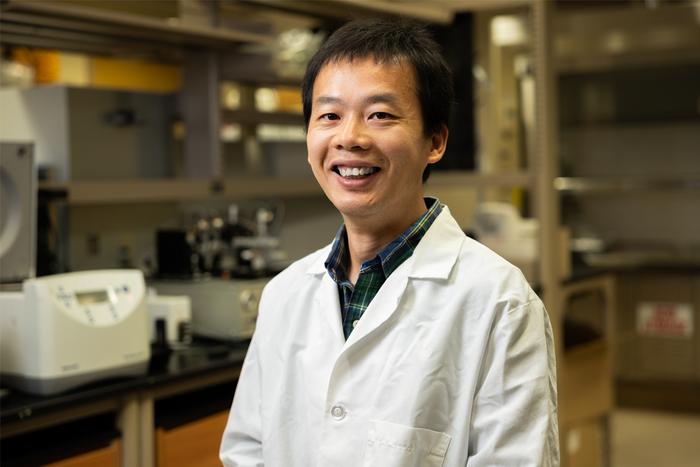Building upon his previous nanoparticle research, Xiaohu Xia received a National Institutes of Health grant to further enhance the sensitivity and accuracy of enzyme-linked immunosorbent assay (ELISA) testing to screen for cancers and other diseases.
(Video interview with researcher + B-roll)

Credit: Antoine Hart, University of Central Florida
Building upon his previous nanoparticle research, Xiaohu Xia received a National Institutes of Health grant to further enhance the sensitivity and accuracy of enzyme-linked immunosorbent assay (ELISA) testing to screen for cancers and other diseases.
(Video interview with researcher + B-roll)
By Eddy Duryea ’13 – Early discovery of debilitating diseases such as cancer or dementia is critical in determining treatment and saving lives.
UCF Department of Chemistry Associate Professor Xiaohu Xia recently received a $1.3 million R01 grant from the National Institutes of Health to continue his promising nanoparticle research that could drastically improve disease detection accuracy by more than 300-times.
The NIH awards R01 grants to investigators for mature research projects that are hypothesis-driven with strong preliminary data like Xia’s.
“In our preliminary laboratory results, we have demonstrated that our nanoparticle-based artificial enzymes are able to improve the detection sensitivity by about 300 times better than the current assets in the market,” he says.
His research spans four years, and it focuses on enhancing the diagnostic efficacy of enzyme-linked immunosorbent assay (ELISA) testing by using specially tailored nickel-platinum nanoparticles that will bind to specific disease biomarkers – such as proteins and hormones – in bodily fluid samples.
Xia is the sole principal investigator, but he will oversee postdoctoral and graduate students who will assist him.
Although there has been some experimentation with substituting nanoparticles in ELISA testing, there hasn’t been a monumental advancement in diagnostic sensitivity in decades, and Xia says he aims to make the leap through his nanoparticle research.
“ELISA technology is one of the most popular technologies used for screenings of a variety of different diseases,” he says. “For example, when you go to the doctor’s office and do your annual physical exam, the bloodwork may use ELISA to detect a variety of different biomarkers. But to breakthrough this technology, you have to completely replace the natural enzyme with something else.”
The switch from using traditional peroxidase found in horseradish root to artificial enzyme “mimics” comprised of nanoparticles could result in numerous benefits, the researcher says. Xia says the nanoparticles are significantly more stable and active, which could mean more reliable and accurate ELISA test results.
“In commercial technology, people are using natural enzymes that are extracted from plants,” Xia says. “In our technology, we’re going to replace the natural enzyme with our artificial enzymes which are made of metal nanoparticles. The artificial enzymes are much more efficient than natural enzymes so that means were going to have a stronger color signal which can substantially improve the detection sensitivity of this technology.”
In this study, Xia endeavors to build and maximize the nanoparticles’ capabilities while demonstrating and confirming their efficacy in clinical use by testing different disease biomarkers in human blood samples. He says he plans to fine-tune the structure of the nanoparticles to engineer the most optimal artificial enzymes for diagnostics.
It will be the first time his nanoparticles will interact with clinical samples, Xia says.
“We’re going to further improve the sensitivity by using the unique nanoparticles and to use two cancers for demonstration,” he says. “In this project, we propose to detect prostate cancer and colorectal cancer in the early stages in blood. With our new technology, we hope to achieve early diagnosis of these cancers.”
The nanoparticles will serve as enhanced artificial “mimics” of conventional enzymes to bond and react in a way that will show color when combined with bioreceptors, such as antibodies, if the target disease biomarkers are present.
When a biomarker is detected, the test generates a visible color output that can be used to quantify its concentration. The stronger the color is, the stronger the concentration. The tests must be highly sensitive to prevent false negatives that could delay treatment or interventions.
Xia is hopeful his research will reveal that the nanoparticles will have record efficiency in providing quicker results and more definitive contrast in the coloring of samples while simplifying the procedures and devices needed for testing.
“Detection sensitivity is critical for diagnostics for significant diseases,” he says. “For the very early stages, the concentration of biomarkers may be very low and not detected by conventional ELISA. With our new technology, were aiming to substantially improve the sensitivity so we can detect even low concentrations of biomarkers in patient samples.”
He aspires to use the foundational knowledge gained from his initial research in 2021 to impact the general field of in vitro diagnostics by offering a type of ultraefficient artificial enzymes that are suitable for many diagnostic technologies even beyond ELISA.
“The ultimate goal we want to achieve is early detection of significant diseases like cancer and in the future, we also want to detect some other very challenging diseases like maybe even Alzheimer’s Disease,” Xia says.
Researcher’s Credentials
Xia joined UCF’s Department of Chemistry, part of UCF’s College of Sciences, in 2018. He has a joint appointment in UCF’s NanoScience Technology Center. Prior to his appointment at UCF, he worked at Michigan Technological University as an assistant professor and at Georgia Institute of Technology as a postdoctoral researcher.



